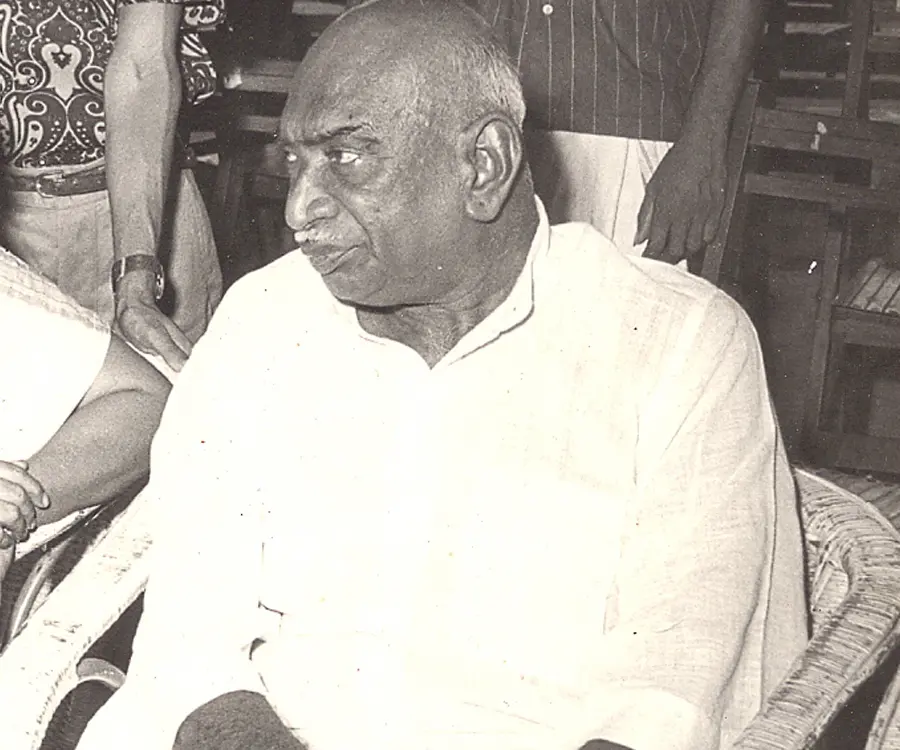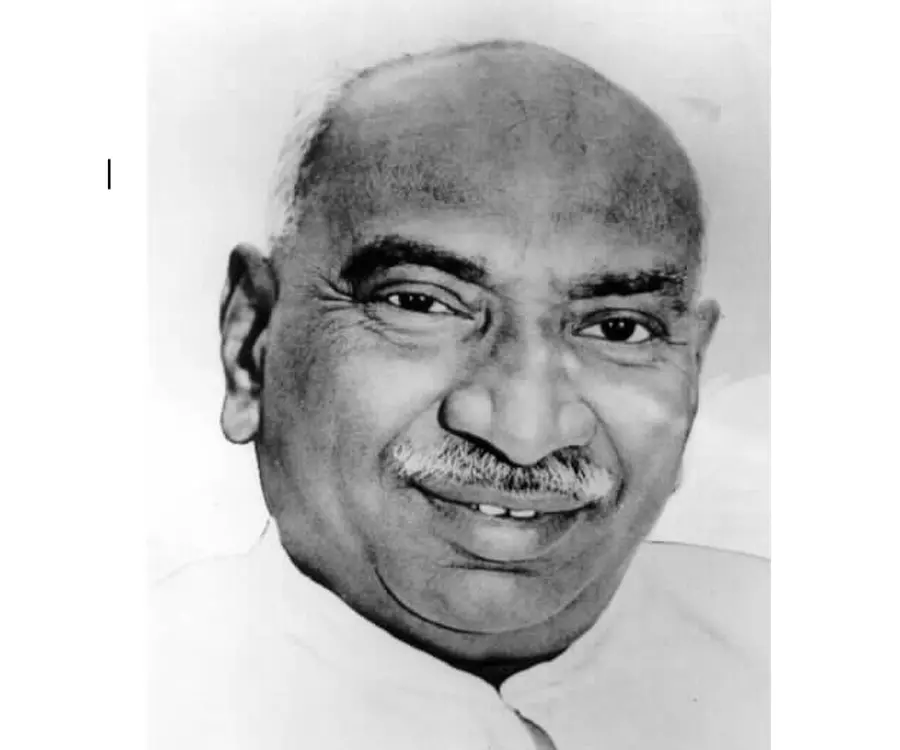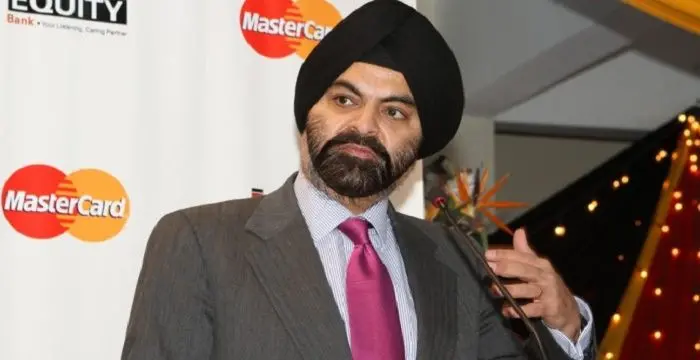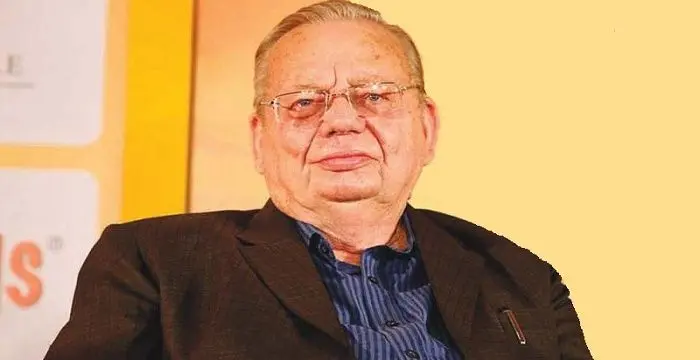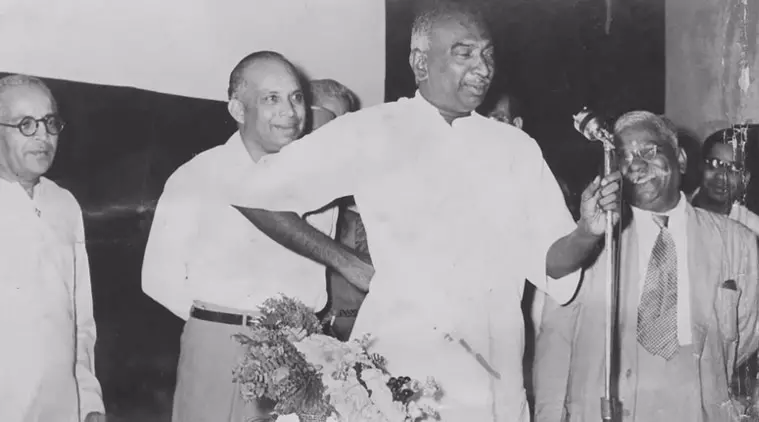
K. Kamaraj - Former Chief Minister of Tamil Nadu, Timeline and Life
K. Kamaraj's Personal Details
K
| Information | Detail |
|---|---|
| Birthday | July 15, 1903 |
| Died on | October 2, 1975 |
| Nationality | Indian |
| Famous | Leaders, Political Leaders, Former Chief Minister of Tamil Nadu |
| Known as | Kumarasami Kamaraj |
| Birth Place | Virudhunagar, Tamil Nadu, India |
| Gender | Male |
| Sun Sign | Cancer |
| Born in | Virudhunagar, Tamil Nadu, India |
| Famous as | Former Chief Minister of Tamil Nadu, India |
| Died at Age | 72 |
K. Kamaraj's photo
Who is K. Kamaraj?
Kumaraswamy Kamaraj was a powerful Indian politician, activist and statesman who played an important role in pre and post-Independent politics. Born in a moderate middle-class family, Kamaraj’s tryst with politics began early. His increasing interest in the country’s political system finally culminated when he became a full time worker of the Congress during India’s struggle for independence. Kamaraj’s humble beginning did not deter him as he persistently worked to contribute actively to the Congress’ struggle to overthrow the foreign rule. From being merely a campaigner, he rose to become a legislator in the Madras Presidency. The high point in his career came when he became the Chief Minister of Madras. Under his administration, Madras propelled forward and prospered. The education rate which was merely 7% rose to the magnanimous 37% with opening of new schools and education reforms. Irrigation and industry flourished making Madras one of the leaders of industrialization. Interestingly, Kamaraj continued to contribute even after his premiership, as President of the Indian National Congress. For his immense contribution, he was decorated with country’s highest civilian award, Bharat Ratna, posthumously.
// Famous Political Leaders
Edi Rama
Edi Rama is the current Prime Minister of Albania. Check out this biography to know about his childhood, life, achievements, works & timeline.
Khalifa bin Zayed Al Nahyan
Sheikh Khalifa bin Zayed Al Nahyan is the current President of the United Arab Emirates (UAE). Check out this biography to know about his birthday, childhood, family life, achievements and fun facts about him.
Leo Varadkar
Cam Leo Varadkar is the current Taoiseach—the Prime Minister—of the Republic of Ireland. Check out this biography to know about his childhood, family life, achievements and other facts about his life.
Childhood & Early Life
Kumaraswami Kamaraj was born on July 15, 1903 at Virudhunagar, Tamil Nadu to Kumaraswamy and Sivakamiv Ammaiar. His father was a merchant. He had a younger sister Nagammal.
In 1907, Kamaraj enrolled at a traditional school. The following year, he enrolled at the Yenadhi Narayana Vidhya Salai but after a year of studies he shifted to Virudupatti High School.
Tragedy struck young Kamaraj when he was merely six. His father died and his mother was forced to support her family. To help his mother, Kamaraj dropped out of school in 1914 to support his family.
Career
Kamaraj started his career doing odd jobs. He worked at his uncle’s provision shop. It was during this time that Kamaraj developed interest in politics. He was an avid newspaper reader and kept himself updated with the current events. He soon became involved with the political processions and public meetings and acquainted himself with the Indian Home Rule Movement.
The 1919 Jallianwala Bagh Massacre was a turning point in Kamaraj’s life. The killing of innocent people instigated a rage of fury and vehemence in Kamaraj who decided to work actively in India’s struggle for freedom and bring an end to British Raj.
Kamaraj’s growing interest in politics was not supported by his family who sent him to Thiruvananthapuram where his second uncle stayed. However, Kamaraj’s passion for politics could not be curtailed in Thiruvananthapuram as well. He participated in the Vaikom Satyagraha led by George Joseph of the Congress, against the atrocities of the higher caste Hindus on the Harijans. Kamaraj met Mahatma Gandhi, India’s face of freedom struggle, at the Madurai’s Congress meet. He was inspired by the latter’s simplicity and non-violence movement.
His political activities in Thiruvananthapuram annoyed his family to the point that he was called back. Though the elders in the family persuaded Kamaraj to stop getting involved in country’s politics, it was without much result. They even tried to marry him off but Kamaraj resolutely disagreed.
In 1920, he joined Congress as a full time worker. He actively worked as political campaigner, organizing public meetings and carrying the Congress propaganda.
Early in his career as a political activist, he participated in many events as a part of the Non-Violent Movement including the Nagpur Flag Satyagraha, Sword Satyagraha, Neil Statue Satyagraha and so on. After joining the Congress, he participated in almost all agitations and demonstrations against the British rule.
In 1930, Kamaraj participated in the Rajagopalachari-led Salt Satyagraha Movement in Vedaranyam. He was sentenced for two years. However, his term of imprisonment was cut short following the Gandhi-Irwin Pact that led to his release in 1931.
In 1932, despite ban on public meetings and procession in Madras, he led processions and demonstrations which subsequently led to his arrest and one year imprisonment. In 1933, Kamaraj was yet again charged with involvement in the Virudhunagar bomb case. However, he was acquitted after not being found guilty.
In 1936, Kamaraj’s guru Satyamurti was elected President of the Provincial Congress. The latter appointed Kamaraj as the General Secretary. Four years later, the duo swapped positions strengthening the party base through their leadership skills.
In 1942, he attended the All India Congress Meet in Bombay where Gandhi’s Quit India Movement bore its roots. He spread the propaganda material to Trichy, Tanjore, Ranipet and Madurai and for the same was arrested and imprisoned for three years. During his term in jail, he read and self-educated himself
After India’s independence in 1947 he was elected a member of the Working Committee of the Congress. He was also a member of the Constituent Assembly that drafted the constitution. In 1951 he contested and won a seat in the elections to the first Lok Sabha.
In 1954, he was elected as the Chief Minister of the Madras State. He reluctantly took up the post and nominated his co-contestants C. Subramaniam and M. Bhakthavatsalam in his cabinet. Kamaraj’s motto as Chief Minister was to work for the welfare of the people.
Under Kamaraj, Madras made immense progress in education and trade. New schools were opened and education was made free and compulsory for all up to 11th Standard. Every village had a primary school and every Panchayat a high school. He even introduced the concept of Mid-Day Meal Scheme for lakhs of poor and deprived children. To eradicate caste, creed and class differences, he introduced school uniform. Such was the progress under his administration that the education rate augmented from merely 7% to 37%.
Education was the primary focus of Kamaraj’s Government but he did not overlook other sectors. In fact, he came up with major irrigation schemes that led to the building of dams and canals. Farmers were given facilities and subsidized loans. He also administered the setting up of major industries under his governance such as Neyveli Lignite Corporation, BHEL, Manali Oil Refinery, Hindustan raw photo film factory, surgical instruments factory, a railway coach factory and so on. Industries such as paper, sugar, chemicals and cement were also established during this period.
Kamaraj’s excellence as a leader and administrator was evident from the fact that he remained the Chief Minister of the State for three consecutive terms, being re-elected in 1957 and later in 1962. Under his administration, Nehru claimed Madras to be the ‘best administered state in India’
In 1963, he resigned from his post of the Chief Minister to serve a greater purpose. Congress which was losing its vigour and shine needed a revamp of sorts. He came up with a plan which was called the ‘Kamaraj Plan’. He proposed that all senior Congress leaders should resign from their post and devote their energy towards revitalization of the Congress. It was mainly done to refrain the leaders from the temptation of power and instead re-commit them to party objectives and motto. The Plan was a major hit as a number of ministers like Lal Bahadur Shastri, Jagjivan Ram, Morarji Desai and S.K. Patil resigned from their posts.
In 1964, he was elected the President of the All India Congress. During his term as the President, he successfully steered the nation through the stormy years post Nehru’s death. He refused to take up Prime Ministerial office twice, giving it to Lal Bahadur Shastri and Indira Gandhi in 1964 and 1966 respectively.
During the 1969 split of Congress, Kamaraj became the leader of the Indian National Congress (Organisation) in Tamil Nadu. However, in 1971 the party failed miserably but he retained his position until his death in 1975.
Major Works
Though Kamaraj’s role in politics was significant all through, starting off as a political activist and later as the prominent leader of the Indian Independence Movement, his most important contribution came later in his career as the Chief Minister of Madras State. Under his governance, Madras became one of the best administered states of the country. He emphasized on educational reforms, introducing free compulsory education. He established new schools and introduced the concept of midday meal scheme under which lakhs of poor and deprived children were provided food. He also tried to get rid of caste and creed differences. Irrigation and industry also prospered and grew under his three-consecutive term governance.
Personal Life & Legacy
Kamaraj breathed his last on October 2, 1975 in his sleep. He was 72 years of age.
Posthumously, Kamaraj was bestowed with the nation’s highest civilian honour, the Bharat Ratna in 1976.
He was proclaimed with the title of ‘Kalvi Thanthai’ or Father of Education in Tamil Nadu.
Chennai airport named its domestic terminal ‘Kamaraj Terminal’.
Several roads and streets across the country are named to honor Kamaraj’s contribution in Indian politics and governance such as Chennai's beach road which bears the name ‘Kamarajar Salai’. Bangalore's North Parade Road and Parliament road in New Delhi were renamed ‘K. Kamaraj Road’.
A university in Madurai was inaugurated under his name, Madurai Kamaraj University, honouring his educational policies as the CM of Madras.
// Famous Leaders
Edi Rama
Edi Rama is the current Prime Minister of Albania. Check out this biography to know about his childhood, life, achievements, works & timeline.
Tecumseh
Tecumseh was a Native American leader of the Shawnee clan. This biography profiles his childhood, life and timeline.
Khalifa bin Zayed Al Nahyan
Sheikh Khalifa bin Zayed Al Nahyan is the current President of the United Arab Emirates (UAE). Check out this biography to know about his birthday, childhood, family life, achievements and fun facts about him.
K. Kamaraj's awards
| Year | Name | Award |
|---|---|---|
Other | ||
| 0 | Bharat Ratna | |
| 0 | 1976 | |
K. Kamaraj biography timelines
- // 15th Jul 1903Kumaraswami Kamaraj was born on July 15, 1903 at Virudhunagar, Tamil Nadu to Kumaraswamy and Sivakamiv Ammaiar. His father was a merchant. He had a younger sister Nagammal.
- // 1907In 1907, Kamaraj enrolled at a traditional school. The following year, he enrolled at the Yenadhi Narayana Vidhya Salai but after a year of studies he shifted to Virudupatti High School.
- // 1914Tragedy struck young Kamaraj when he was merely six. His father died and his mother was forced to support her family. To help his mother, Kamaraj dropped out of school in 1914 to support his family.
- // 1919The 1919 Jallianwala Bagh Massacre was a turning point in Kamaraj’s life. The killing of innocent people instigated a rage of fury and vehemence in Kamaraj who decided to work actively in India’s struggle for freedom and bring an end to British Raj.
- // 1920In 1920, he joined Congress as a full time worker. He actively worked as political campaigner, organizing public meetings and carrying the Congress propaganda.
- // 1930 To 1931In 1930, Kamaraj participated in the Rajagopalachari-led Salt Satyagraha Movement in Vedaranyam. He was sentenced for two years. However, his term of imprisonment was cut short following the Gandhi-Irwin Pact that led to his release in 1931.
- // 1932 To 1933In 1932, despite ban on public meetings and procession in Madras, he led processions and demonstrations which subsequently led to his arrest and one year imprisonment. In 1933, Kamaraj was yet again charged with involvement in the Virudhunagar bomb case. However, he was acquitted after not being found guilty.
- // 1936In 1936, Kamaraj’s guru Satyamurti was elected President of the Provincial Congress. The latter appointed Kamaraj as the General Secretary. Four years later, the duo swapped positions strengthening the party base through their leadership skills.
- // 1942In 1942, he attended the All India Congress Meet in Bombay where Gandhi’s Quit India Movement bore its roots. He spread the propaganda material to Trichy, Tanjore, Ranipet and Madurai and for the same was arrested and imprisoned for three years. During his term in jail, he read and self-educated himself
- // 1947 To 1951After India’s independence in 1947 he was elected a member of the Working Committee of the Congress. He was also a member of the Constituent Assembly that drafted the constitution. In 1951 he contested and won a seat in the elections to the first Lok Sabha.
- // 1954In 1954, he was elected as the Chief Minister of the Madras State. He reluctantly took up the post and nominated his co-contestants C. Subramaniam and M. Bhakthavatsalam in his cabinet. Kamaraj’s motto as Chief Minister was to work for the welfare of the people.
- // 1957 To 1962Kamaraj’s excellence as a leader and administrator was evident from the fact that he remained the Chief Minister of the State for three consecutive terms, being re-elected in 1957 and later in 1962. Under his administration, Nehru claimed Madras to be the ‘best administered state in India’
- // 1963In 1963, he resigned from his post of the Chief Minister to serve a greater purpose. Congress which was losing its vigour and shine needed a revamp of sorts. He came up with a plan which was called the ‘Kamaraj Plan’. He proposed that all senior Congress leaders should resign from their post and devote their energy towards revitalization of the Congress. It was mainly done to refrain the leaders from the temptation of power and instead re-commit them to party objectives and motto. The Plan was a major hit as a number of ministers like Lal Bahadur Shastri, Jagjivan Ram, Morarji Desai and S.K. Patil resigned from their posts.
- // 2nd Oct 1975Kamaraj breathed his last on October 2, 1975 in his sleep. He was 72 years of age.
- // 1976Posthumously, Kamaraj was bestowed with the nation’s highest civilian honour, the Bharat Ratna in 1976.
// Famous Indian peoples
Sunny Leone
Sunny Leone is an actress and model. Check out this biography to know about her birthday, childhood, family life, achievements and fun facts about her.
Swami Vivekananda
Swami Vivekananda was the chief disciple of Sri Ramakrishna, and was responsible for awakening India spiritually. Check this biography to know in detail about his life, profile and timeline.
Ajaypal Banga
Ajaypal Banga is an Indian-American business executive who is the CEO of MasterCard. Check out this biography to know about his childhood, family life, achievements and fun facts about him.
Ruskin Bond
Ruskin Bond is an award winning Indian author of British descent. This biography of Ruskin Bond provides detailed information about his childhood, life, achievements, works & timeline.
Urmila Matondkar
Urmila Matondkar is an Indian film actress known for her films like ‘Rangeela’ and ‘Satya.’ Check out this biography to know about her childhood, family life, achievements and fun facts about her.
Ashoka
Ashoka was the third emperor of the Mauryan Dynasty and ruled almost the entire Indian subcontinent. This biography profiles his childhood, life, reign, achievements and timeline
K. Kamaraj's FAQ
What is K. Kamaraj birthday?
K. Kamaraj was born at 1903-07-15
When was K. Kamaraj died?
K. Kamaraj was died at 1975-10-02
Which age was K. Kamaraj died?
K. Kamaraj was died at age 72
Where is K. Kamaraj's birth place?
K. Kamaraj was born in Virudhunagar, Tamil Nadu, India
What is K. Kamaraj nationalities?
K. Kamaraj's nationalities is Indian
What is K. Kamaraj's sun sign?
K. Kamaraj is Cancer
How famous is K. Kamaraj?
K. Kamaraj is famouse as Former Chief Minister of Tamil Nadu, India
